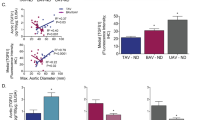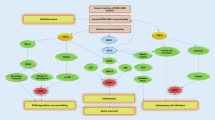Abstract
An aortic aneurysm is characterized by widening of the aortic lumen diameter with adverse remodelling of the vascular extracellular matrix. A thoracic aortic aneurysm (TAA) is highly prevalent in patients with a bicuspid aortic valve (BAV). We investigated the structural remodelling in the aneurysmal ascending aorta in correlation to molecular alterations in male versus female BAV-TAA patients. Aneurysmal aortic samples (diameter >4.4 cm) from male and female patients were compared to non-aneurysmal non-BAV samples. The diameter of the aneurysmal aorta was smaller in females but comparable to that of male patients when normalized to body mass index. Disorganized elastin fibres and reduced elastin protein were found in samples from males and females with BAV-TAA. However, disarrayed collagen fibres and reduced protein were detected only in aortas from males with BAV-TAA. Elastin and collagen I messenger RNA (mRNA) levels were comparable in the BAV-TAA and control groups of both genders, suggesting post-translation degradation. Total elastase activity was elevated similarly in both genders. The activity of MT1-MMP, a potent collagenase, was increased more in aortic samples from males than females with BAV-TAA samples. MMP8 and MMP13 were lower whereas MMP2 was higher in female compared to samples from male BAV-TAA group. TIMP3 and TIMP4 decreased similarly in both genders, while TIMP2 increased in the female BAV-TAA group. Lower smooth muscle cell density in the medial layer of aortas from males with BAV-TAA samples corresponded to the increased caspase-3 cleavage compared to that of females. Conclusion: We report a gender-dependent MMP/TIMP axis, collagen remodelling and smooth muscle cell (SMC) survival in the BAV-TAA aorta. The elevated TIMP2 could protect against the collagenolytic activity of MT1-MMP, leading to reduced collagen disarray and degradation in female BAV.
Key message
-
More collagen degradation/disarray and smooth muscle cell loss in male BAV-TAA patients.
-
Similar elastin degradation/disarray in the aneurysmal aorta of both genders.
-
Reduced collagen and elastin in BAV-TAA due to enhanced degradation, not reduced synthesis.
-
Elevated TIMP2 in female BAV-TAA aortas protects against collagen degradation by MT1-MMP.





Similar content being viewed by others
References
Control. NCfIPa (1999-2007) WISQARS leading causes of death reports. http://webappa.cdc.gov/sasweb/ncipc/leadcaus10.html
Ruddy JM, Jones JA, Ikonomidis JS (2013) Pathophysiology of thoracic aortic aneurysm (TAA): is it not one uniform aorta? Role of embryologic origin. Prog Cardiovasc Dis 56:68–73
Ruddy JM, Jones JA, Spinale FG, Ikonomidis JS (2008) Regional heterogeneity within the aorta: relevance to aneurysm disease. J Thorac Cardiovasc Surg 136:1123–1130
Michelena HI, Khanna AD, Mahoney D, Margaryan E, Topilsky Y, Suri RM, Eidem B, Edwards WD, Sundt TM 3rd, Enriquez-Sarano M (2011) Incidence of aortic complications in patients with bicuspid aortic valves. JAMA 306:1104–1112
Hope MD, Hope TA, Crook SE, Ordovas KG, Urbania TH, Alley MT, Higgins CB (2011) 4D flow CMR in assessment of valve-related ascending aortic disease. J Am Coll Cardiol Img 4:781–787
Maleki S, Bjorck HM, Folkersen L, Nilsson R, Renner J, Caidahl K, Franco-Cereceda A, Lanne T, Eriksson P (2013) Identification of a novel flow-mediated gene expression signature in patients with bicuspid aortic valve. J Mol Med (Berl) 91:129–139
Loffredo CA (2000) Epidemiology of cardiovascular malformations: prevalence and risk factors. Am J Med Genet 97:319–325
Braverman AC, Guven H, Beardslee MA, Makan M, Kates AM, Moon MR (2005) The bicuspid aortic valve. Curr Probl Cardiol 30:470–522
Bonow RO, Carabello BA, Kanu C, De Leon AC Jr, Faxon DP, Freed MD, Gaasch WH, Lytle BW, Nishimura RA, O’Gara PT et al (2006) ACC/AHA 2006 guidelines for the management of patients with valvular heart disease: a report of the American College of Cardiology/American Heart Association Task Force on Practice Guidelines (writing committee to revise the 1998 Guidelines for the Management of Patients With Valvular Heart Disease): developed in collaboration with the Society of Cardiovascular Anesthesiologists: endorsed by the Society for Cardiovascular Angiography and Interventions and the Society of Thoracic Surgeons. Circulation 114:e84–e231
Boyum J, Fellinger EK, Schmoker JD, Trombley L, McPartland K, Ittleman FP, Howard AB (2004) Matrix metalloproteinase activity in thoracic aortic aneurysms associated with bicuspid and tricuspid aortic valves. J Thorac Cardiovasc Surg 127:686–691
Ikonomidis JS, Jones JA, Barbour JR, Stroud RE, Clark LL, Kaplan BS, Zeeshan A, Bavaria JE, Gorman JH 3rd, Spinale FG et al (2007) Expression of matrix metalloproteinases and endogenous inhibitors within ascending aortic aneurysms of patients with bicuspid or tricuspid aortic valves. J Thorac Cardiovasc Surg 133:1028–1036
Ikonomidis JS, Ruddy JM, Benton SM Jr, Arroyo J, Brinsa TA, Stroud RE, Zeeshan A, Bavaria JE, Gorman JH 3rd, Gorman RC et al (2012) Aortic dilatation with bicuspid aortic valves: cusp fusion correlates to matrix metalloproteinases and inhibitors. Ann Thorac Surg 93:457–463
LeMaire SA, Wang X, Wilks JA, Carter SA, Wen S, Won T, Leonardelli D, Anand G, Conklin LD, Wang XL et al (2005) Matrix metalloproteinases in ascending aortic aneurysms: bicuspid versus trileaflet aortic valves. J Surg Res 123:40–48
Basu R, Fan D, Kandalam V, Lee J, Das SK, Wang X, Baldwin TA, Oudit GY, Kassiri Z (2012) Loss of Timp3 gene leads to abdominal aortic aneurysm formation in response to angiotensin II. J Biol Chem 287:44083–44096
Basu R, Lee J, Morton JS, Takawale A, Fan D, Kandalam V, Wang X, Davidge ST, Kassiri Z (2013) TIMP3 is the primary TIMP to regulate agonist-induced vascular remodelling and hypertension. Cardiovasc Res 98:360–371
Kandalam V, Basu R, Moore L, Fan D, Wang X, Jaworski DM, Oudit GY, Kassiri Z (2011) Lack of tissue inhibitor of metalloproteinases 2 leads to exacerbated left ventricular dysfunction and adverse extracellular matrix remodeling in response to biomechanical stress. Circulation 124:2094–2105
Abdulkareem N, Soppa G, Jones S, Valencia O, Smelt J, Jahangiri M (2013) Dilatation of the remaining aorta after aortic valve or aortic root replacement in patients with bicuspid aortic valve: a 5-year follow-up. Ann Thorac Surg 96:43–49
Abaci O, Kocas C, Kilickesmez KO, Uner S, Kucukoglu S (2013) Matrix metalloproteinase-2 and -9 levels in patients with dilated ascending aorta and bicuspid aortic valve. Echocardiography 30:121–126
Tzemos N, Lyseggen E, Silversides C, Jamorski M, Tong JH, Harvey P, Floras J, Siu S (2010) Endothelial function, carotid-femoral stiffness, and plasma matrix metalloproteinase-2 in men with bicuspid aortic valve and dilated aorta. J Am Coll Cardiol 55:660–668
Pisano C, Maresi E, Balistreri CR, Candore G, Merlo D, Fattouch K, Bianco G, Ruvolo G (2012) Histological and genetic studies in patients with bicuspid aortic valve and ascending aorta complications. Interact Cardiovasc Thorac Surg 14:300–306
Bauer M, Pasic M, Meyer R, Goetze N, Bauer U, Siniawski H, Hetzer R (2002) Morphometric analysis of aortic media in patients with bicuspid and tricuspid aortic valve. Ann Thorac Surg 74:58–62
Della Corte A, Quarto C, Bancone C, Castaldo C, Di Meglio F, Nurzynska D, De Santo LS, De Feo M, Scardone M, Montagnani S et al (2008) Spatiotemporal patterns of smooth muscle cell changes in ascending aortic dilatation with bicuspid and tricuspid aortic valve stenosis: focus on cell-matrix signaling. J Thorac Cardiovasc Surg 135:8–18, 18 e11-12
Ikonomidis JS, Ivey CR, Wheeler JB, Akerman AW, Rice A, Patel RK, Stroud RE, Shah AA, Hughes CG, Ferrari G et al (2013) Plasma biomarkers for distinguishing etiologic subtypes of thoracic aortic aneurysm disease. J Thorac Cardiovasc Surg 145:1326–1333
Mohamed SA, Noack F, Schoellermann K, Karluss A, Radtke A, Schult-Badusche D, Radke PW, Wenzel BE, Sievers HH (2012) Elevation of matrix metalloproteinases in different areas of ascending aortic aneurysms in patients with bicuspid and tricuspid aortic valves. Sci World J 2012:806261
Holmes KW, Maslen CL, Kindem M, Kroner BL, Song HK, Ravekes W, Dietz HC, Weinsaft JW, Roman MJ, Devereux RB et al (2013) GenTAC registry report: gender differences among individuals with genetically triggered thoracic aortic aneurysm and dissection. Am J Med Genet A 161A:779–786
Lepidi S, Kenagy RD, Raines EW, Chiu ES, Chait A, Ross R, Clowes AW (2001) MMP9 production by human monocyte-derived macrophages is decreased on polymerized type I collagen. J Vasc Surg 34:1111–1118
Kandalam V, Basu R, Abraham T, Wang X, Soloway PD, Jaworski DM, Oudit GY, Kassiri Z (2010) TIMP2 deficiency accelerates adverse post-myocardial infarction remodeling because of enhanced MT1-MMP activity despite lack of MMP2 activation. Circ Res 106:796–808
Takawale A, Fan D, Basu R, Shen M, Parajuli N, Wang W, Wang X, Oudit GY, Kassiri Z (2014) Myocardial recovery from ischemia-reperfusion is compromised in the absence of tissue inhibitor of metalloproteinase 4. Circ Heart Fail. doi:10.1161/CIRCHEARTFAILURE.114.001113
Wagsater D, Paloschi V, Hanemaaijer R, Hultenby K, Bank RA, Franco-Cereceda A, Lindeman JH, Eriksson P (2013) Impaired collagen biosynthesis and cross-linking in aorta of patients with bicuspid aortic valve. J Am Heart Assoc 2:e000034
Zhang X, Thatcher S, Wu C, Daugherty A, Cassis LA (2014) Castration of male mice prevents the progression of established angiotensin II-induced abdominal aortic aneurysms. J Vasc Surg
Zhang X, Thatcher SE, Rateri DL, Bruemmer D, Charnigo R, Daugherty A, Cassis LA (2012) Transient exposure of neonatal female mice to testosterone abrogates the sexual dimorphism of abdominal aortic aneurysms. Circ Res 110:e73–e85
Bloomer LD, Bown MJ, Tomaszewski M (2012) Sexual dimorphism of abdominal aortic aneurysms: a striking example of “male disadvantage” in cardiovascular disease. Atherosclerosis 225:22–28
Wu XF, Zhang J, Paskauskas S, Xin SJ, Duan ZQ (2009) The role of estrogen in the formation of experimental abdominal aortic aneurysm. Am J Surg 197:49–54
Laser A, Ghosh A, Roelofs K, Sadiq O, McEvoy B, DiMusto P, Eliason J, Upchurch GR Jr (2014) Increased estrogen receptor alpha in experimental aortic aneurysms in females compared with males. J Surg Res 186:467–474
Yeap BB, Hyde Z, Norman PE, Chubb SA, Golledge J (2010) Associations of total testosterone, sex hormone-binding globulin, calculated free testosterone, and luteinizing hormone with prevalence of abdominal aortic aneurysm in older men. J Clin Endocrinol Metab 95:1123–1130
Acknowledgments
This study was supported in part by a Heart and Stroke Foundation operating grant to Z.K. and a CIHR grant to M.S.M. M.S.M. is supported by the Heart and Stroke Foundation of Canada. Z.K. is an Alberta Innovates-Health Solutions (AI-HS) scholar. G.Y.O. is a Clinician-Investigator Scholar of AI-HS. M.S. is supported by the China Scholarship Council (CSC).
Disclosures
None.
Author information
Authors and Affiliations
Corresponding author
Rights and permissions
About this article
Cite this article
Lee, J., Shen, M., Parajuli, N. et al. Gender-dependent aortic remodelling in patients with bicuspid aortic valve-associated thoracic aortic aneurysm. J Mol Med 92, 939–949 (2014). https://doi.org/10.1007/s00109-014-1178-6
Received:
Revised:
Accepted:
Published:
Issue Date:
DOI: https://doi.org/10.1007/s00109-014-1178-6




